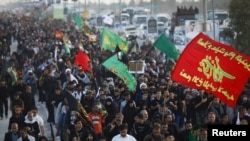A pilgrimage intended to rival the Hajj gathers millions of Shiites in Iraq this coming weekend. An event that showcases a variety of socio-political dynamics from rivalry between Iran and Saudi Arabia to Ayatollah Ali Khamenei's personality cult, to tasting Iraqi cuisines.
One million and seven hundred thousand Iranians have registered for the march to Karbala in Iraq to mark Arbaeen (October 30), the 40th day after the martyrdom of Imam Hussain, the third Imam of the Shiite sect in 680 AD, Tasnim news agency reported on Thursday October 25.
The pilgrimage, has been highly popular in recent years among devoted Shiite Muslims in Iran and in particular among those who subscribe to the Islamic Republic ideology.
In previous years up to two million Iranians took part in the pilgrimage encouraged and partly funded or subsidized by the government. Various government organizations also reportedly send thousands of their staff members, often like a paid holiday.
This year the contingent includes hundreds from the Tehran Municipality.
According to Tasnim, some 47,000 Pakistani pilgrims have arrived in Iran during recent days to join the long March to Karbala in Southern Iraq.
Every pilgrim is allowed to purchase up to 100,000 Iraqi dinars ($85) at the subsidized rate of 96 rials per dinar, before they leave for the Iraqi border and Iraqi bank notes will be given to them at the Iraqi side of the border or in certain places in a few Iraqi cities where Shiite shrines are located.
Iran's leading economic daily Donya-ye Eqtesad reported on October 13 that President Hassan Rouhani has approved a 35% discount in the rate of exchange for the Arbaeen pilgrims, in addition to the subsidized fixed sum. Some of Iran's reformist media protested to Rouhani for his decision, but IRGC-linked daily Javan supported the government's measure.
Reports during the past days say Iranian pilgrims were facing difficulties in Iraq while trying to cash in the money orders they were given by the banks in Iran.
As far as the Iranian government is concerned, more political significance than religious importance has been attached to the pilgrimage in recent years. Officials did not conceal their inclination to see and portray Iraq as the strategic depth of the Islamic Republic.
In several speeches by Iranian officials they said that the pilgrimage marked Iran's influence in the region and showed that Tehran was capable of restoring security during such a huge gathering outside its borders. Middle ranking officials talk about Khamenei's welcome leadership in the Muslim world, to please the supreme leader.
The Arbaeen March also reveals the rivalry between Iran and Saudi Arabia. Both countries claim leadership of the Muslim world.According to Khat-e Hezballah, a pamphlet published by Khamenei's office, some 22 million Shiites took part in the march in 2014, while only some two million Shiite and Sunni Muslims took part in the Hajj pilgrimage in Saudi Arabia in the same year.
Khamenei puts the overall number of Arbaeen pilgrims at 20 million in a recent tweet.
Social media users have noticed changes in the form of Arbaeen pilgrimage in recent years, which has turned into a massive whirling crowd marching around and outside Mausoleums in Iraq, in a way that is reminiscent of the way Hajj pilgrims move in Mecca.
Pictures tweeted by Iran's Telecommunications Minister Mohamad Javad Azari Jahromi shows the size of the crowd and the way pilgrims move around the shrines in Karbala.
An analysis published on the Iranian state TV's website probed into the significance of the Arbaeen pilgrimage from political and sociological points of view, calling it an annual event that highlights the Shiite identity in Iran and Iraq and the unity among the sect's members.
The analysis calls the march "an anti-imperialist event" in which millions coming from various countries take part.
The political importance the Islamic Republic has attached to the Arbaeen pilgrimage, appears to have changed a traditionally one-day event into a gathering that goes on for about two weeks as Iranians tend to visit religious sites in various Iraqi cities, and involves not only remembering a religious event, but adds other cultural dimensions to it. Many pilgrims, for instance, write about food in Iraq.
This one is about lime juice extracted from semi-dried Iraqi fruit:
A non-Iranian pilgrim calls the gathering "life-changing":
On the other hand, an Iranian pilgrim says: "Do not believe the propaganda on the TV. The number of Iranians here is rather small and the number of politically-minded even smaller."






